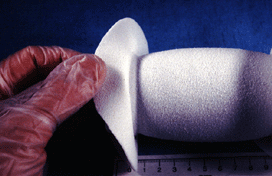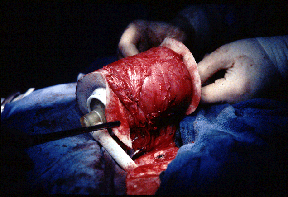|
Medical Devices and
Implants
Our ability to
fabricate medical devices and implants using the proprietary
methods developed at WBI has enabled the company to pursue basic biomedical
research in a variety of fields. Shown below is a device
which converts the force of an electrically stimulated muscle, a
natural endogenous power source, to operate an assist pump contained within the device. The
latissimus dorsi muscle from the upper back is surgically mobilized and wrapped
around the implant. After a period of electrical conditioning using a device
similar to a cardiac pacemaker, the muscle becomes capable of working continuously. It is then triggered to contract in
synchrony with the heart to assist cardiac function. Unlike any
other form of mechanical cardiac assistance, this device requires no
source of external power. In addition, since it uses only the patient's
own tissues, no immune system suppression is needed as with a
cardiac transplant.

The muscle wrapped device is seen below before it is placed within the chest cavity. If successful, this approach provides an alternative
to both cardiac transplantation or the use of externally powered devices, and it offers major advantages in terms of quality of life. This NIH funded program utilizes many of the
core technologies which have been developed at the company to solve
a series of complex problems. While it is a
research phase effort at this point, the potential for this approach is
significant.

|
![]()